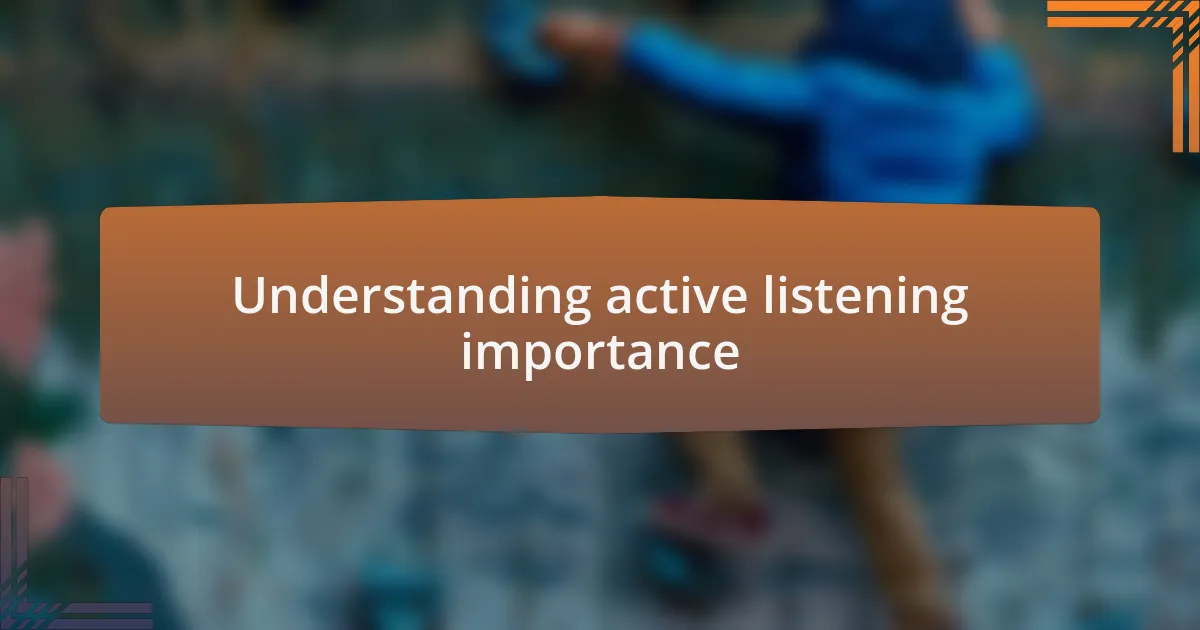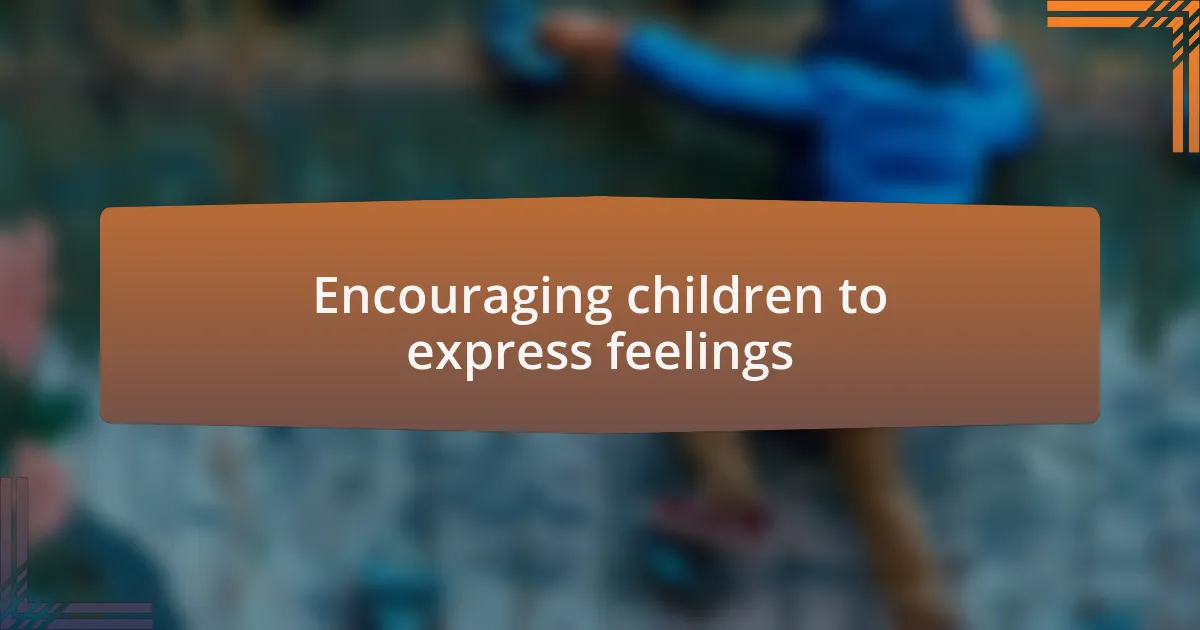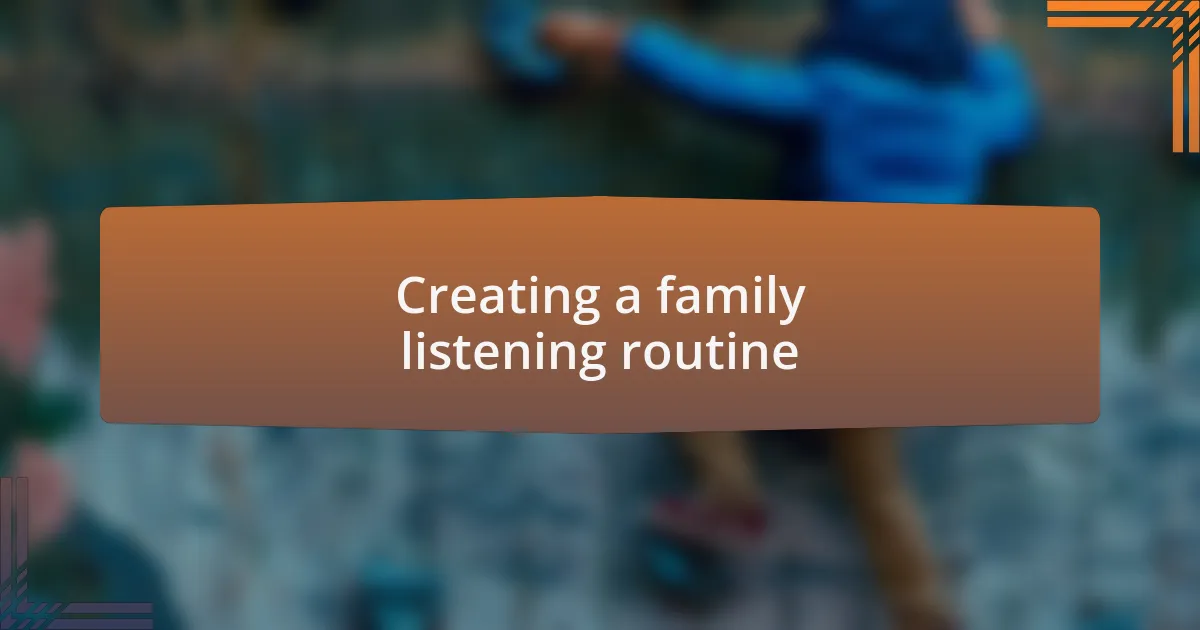Key takeaways:
- Active listening builds trust and understanding in family dynamics, enhancing relationships and emotional intelligence.
- Minimizing distractions and using open-ended questions promote deeper conversations and validate feelings.
- Creating routines for family discussions helps children express emotions, fostering a supportive environment.
- Real-life examples of active listening illustrate its effectiveness in addressing feelings and strengthening connections.

Understanding active listening importance
Active listening is crucial because it fosters trust and understanding in family dynamics. I remember a time when my child felt unheard; after I made a conscious effort to listen attentively, not only did they open up, but our relationship deepened significantly. Isn’t it fascinating how just being present can bridge gaps in communication?
When we truly listen, we show respect for our loved ones’ feelings and viewpoints. I recall an instance when my teenager shared their struggles in school, and my genuine response made them feel valued. What if we all took the time to really hear one another? The potential for healing and connection is enormous.
Moreover, active listening teaches children essential life skills. By practicing this at home, we’re modeling behaviors that will help them in friendships, school, and future workplaces. Think of it as planting the seeds for their emotional intelligence; the impact can be profound as they grow.

Techniques for promoting active listening
One effective technique I use to promote active listening is minimizing distractions during conversations. For instance, when my family gathers for dinner, we make it a point to put down our phones and turn off the television. This simple change encourages everyone to engage fully, enabling deeper discussions. Have you noticed how much easier it is to connect when you aren’t competing with a screen for attention?
Another approach I’ve found helpful is to summarize what a family member has shared before responding. I remember a moment when my child expressed frustration about a friend. Instead of jumping straight to advice, I said, “What I’m hearing is that you feel let down and confused.” This not only validated their feelings but also helped me understand their perspective better. Isn’t it remarkable how confirming someone’s feelings can open up a rich dialogue?
Lastly, I encourage my family to ask open-ended questions. Instead of simply asking, “Did you have a good day?”, I might say, “What was the best part of your day?” This shift invites my kids to share more about their experiences and feelings. I’ve witnessed how this small change can lead to conversations that reveal their inner thoughts, making them feel heard and valued. What techniques have you found to deepen conversations with your loved ones?

Activities to enhance listening skills
One enjoyable activity I introduced to my family is a “listening game,” where we take turns sharing stories while others listen attentively. After each story, the listeners summarize what they heard, adding their own reflections. This not only hones listening skills but also deepens our understanding of each other’s experiences, creating an environment where expressing thoughts becomes more meaningful. Have you ever noticed how much more connected we feel after sharing a story?
We also incorporate themed family nights where conversations revolve around specific topics, like our favorite vacations or dreams for the future. During these nights, I encourage everyone to build on each other’s comments rather than merely waiting for their turn to speak. This approach nurtures active engagement, transforming our discussions into collaborative explorations. I recall one night when a simple conversation about travel dreams turned into a shared vision that brought us closer as we discovered new interests together.
I find creative activities, like listening to audiobooks as a family, can provide an opportunity for discussion and reflection. After an audiobook session, we discuss our favorite characters or unexpected plot twists. I cherish these moments because they naturally provoke curiosity and foster respectful dialogue about differing opinions. How often do we overlook the amazing potential of literature to bring us together?

Encouraging children to express feelings
Creating an environment where children feel comfortable expressing their feelings is crucial. I remember a time when my child came home feeling upset about something that happened at school. Instead of brushing it off, I sat down with them and asked open-ended questions like, “What made you feel that way?” This simple conversation not only allowed them to express their feelings but also taught them that it’s okay to talk about emotions without fear of judgment.
One technique I’ve used is the “feelings chart,” which visually represents different emotions. I often encourage my kids to point to or describe how they’re feeling at any given moment. It’s amazing how quickly they open up about their emotions when given a simple tool like this. Have you ever noticed how little prompts can unlock a treasure trove of feelings?
Sometimes, I share my own feelings during our discussions, which seems to spark a connection. For instance, when I share a time I felt overwhelmed, I can see my children relate to my experience. This mutual sharing fosters an atmosphere where expressing feelings becomes a natural part of our family dynamic. How do you encourage your children to open up?

Creating a family listening routine
Creating a consistent family listening routine is essential for nurturing open communication. I’ve found that setting aside a specific time each week for family discussions truly enhances our connection. During these sessions, everyone shares their highs and lows of the week, similar to a “family check-in.” It’s both comforting and enlightening to hear my children articulate their experiences openly.
In my home, I’ve noticed that using casual prompts helps ease into deeper conversations. For instance, I sometimes ask, “What was your favorite part of today?” This simple question can lead to unexpected topics, revealing not only what excites them but also what challenges they’re facing. It’s fascinating how a light query can morph into a significant dialogue about their feelings, leading to richer understanding among us.
Moreover, I encourage the practice of active listening by modeling it myself. During our discussions, I make a conscious effort to paraphrase what my children share, showing them that their words truly matter. I’ll say, “So you felt really excited when you got to play with your friend?” This not only validates their feelings but also reinforces the importance of listening within our family. How do you think active listening might benefit your family’s discussions?

Real-life examples of active listening
One evening, while we were enjoying dinner, my daughter shared a story about a tough day at school. Rather than interrupting, I leaned in and maintained eye contact, encouraging her to continue. After she finished, I reflected her feelings back to her, saying, “It sounds like you felt really overwhelmed, but also proud of how you handled it.” I could see her visibly relax, knowing that her emotions were acknowledged.
During family game night, I often incorporate active listening techniques. When my son wins a round but is feeling frustrated because his friend didn’t play fair, I pause the game. I ask him to articulate his feelings, validating his experience with phrases like, “That can be really upsetting, especially when you feel let down by someone you trust.” This approach not only helps him process his emotions but also teaches him how to express and manage frustration in healthy ways.
Another instance that stands out to me was a recent family outing where my youngest felt shy and hesitant to join a group activity. Rather than brushing off his feelings, I knelt down to his level and asked, “What part are you feeling unsure about?” By giving him space to voice his concerns, I demonstrated that listening is not just about hearing words—it’s also about understanding the feelings behind them. How might those moments of connection influence your children’s emotional growth?